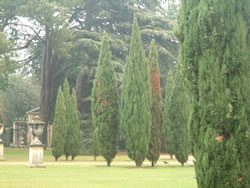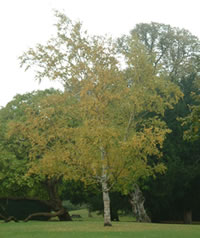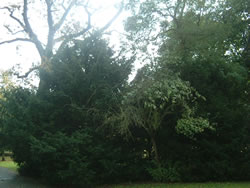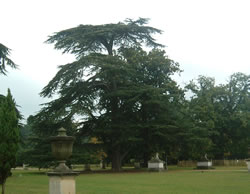We get Head Gardener Fiona Crumley's view on plans to cull Chiswick House trees
|
When the third Earl of Burlington (1694-1753), with the help of William Kent, originally designed the gardens at Chiswick House he drew inspiration from his ‘grand tours’ of Italy. However, today much of his planting has been earmarked for regeneration and has sparked controversy amongst some members of the community.
Emma Brophy went to meet Chiswick House’s recently appointed Head Gardener Fiona Crumley to get the horticulturist’s view on the proposed tree works.
Fiona has had 14 years experience working at the Chelsea Physic Garden, three years at the privately owned Newby Hall garden in North Yorkshire, and a one year placement with London Borough of Enfield Parks Department. She is a member of the Royal Horticultural Society Herbaceous Plant Committee, the RHS Herbaceous Trials Committee and Liveryman of the Worshipful Company of Gardeners amongst other committees.
At the time of her appointment in April 2007, Janie Burford, trustee and member of the interview board, said, “We are very excited to welcome Fiona on board. It’s the first time in many years that we have had such an experienced and enthusiastic horticulturist on site. Her early priority is to work closely with the contractors and Goosefoot Volunteers to improve the presentation of the park and gardens. Fiona will play a crucial role within the team driving forward the renaissance of Chiswick House Gardens.”
“I’ve only been here for four months so I am looking at this regeneration project with a fresh pair of eyes.” said Fiona.
“I see myself as being at the crossroads of horticulture and ecology which are both necessary to produce good biodiversity. It’s all about how you manage a garden. The gardens here lack an under storey of vegetation, the tree stock now needs careful management in order to stop continuing long-term decline in quality. Clearing certain trees will also provide better light which will help create better ground flora and in turn better biodiversity.”
“For example bats. There's no point giving the bats somewhere to live if we don’t provide food for them to eat. This is done by improving the ecology through horticulture which is what we are trying to do here.” she continued.
“Chiswick House is a huge space which is turn very important to this area, not just to the community but also as a garden and its inhabitants. It also links through to Dukes Meadows and onto the Thames which has been found to be vital for migratory birds so it is by no means a stand alone site.”
 There is evidence that Lord Burlington’s classic Italianate gardens, which are said to encapsulate early 18th century garden design, today appear somewhat jaded. In this area 34 Italian Cyprus trees are set to be removed and replaced by 40 new ones. However, the vast Lebanon Cedars, believed to be have been planted by Lord Burlington around 1720 and known to hoards of Chiswick families as ‘the climbing trees’ will remain.
There is evidence that Lord Burlington’s classic Italianate gardens, which are said to encapsulate early 18th century garden design, today appear somewhat jaded. In this area 34 Italian Cyprus trees are set to be removed and replaced by 40 new ones. However, the vast Lebanon Cedars, believed to be have been planted by Lord Burlington around 1720 and known to hoards of Chiswick families as ‘the climbing trees’ will remain.
The Western Lawn, said to be the ‘iconic landscape of the naturalist style of gardening’ and launched the English Landscape Movement, will lose three trees including a Silver Birch and a Horse Chestnut with an aim to reinstate the view from the house down to the waterfall and canal.
Down by the waterside the large weeping willow is to be ‘pollarded’ (a process in which  branches are regularly cut off at a height of 2-3 metres. Pollarding prolongs a tree's life - done regularly, pollarded trees can survive for centuries.)
branches are regularly cut off at a height of 2-3 metres. Pollarding prolongs a tree's life - done regularly, pollarded trees can survive for centuries.)
Fiona said “This project is not for this generation. It should be the case, but many veteran trees have died or are almost dead and we are missing a whole batch of young trees as none have been planted. This is really down to a number of factors but mainly the lack of historical tree management which is hardly surprising considering arboriculture is astonishingly expensive but astonishingly necessary.”
She continued “In some of the more populated areas, old trees are falling or splitting and crushing the young so it’s a case of thinning them out and getting what remains back into good shape. In The Grove [the area to the east of the house] a number of trees simply aren’t healthy and would die anyway if they were not removed – it’s just a matter of when. However, some trees were going to be removed but have been withdrawn from the plans following requests from the public.”
Which was the case of the popular Weeping Willow in the grassy area by the café which will remain as will the mighty Horse Chestnuts, but work will have to be done on the ground around these trees.
“We need to relieve compaction around the base of a number of trees to enable water to drain into the soil better." explains Fiona "The earth around the trunks has been compacted to such an extent – the impact of hundreds of tiny feet – that we really need to do something. Over at Kew, they have developed a technique of placing tubes into the ground and injecting oxygen through them. This breaks up the soil and lets the water get down to where it’s needed.”
 Regarding the exact number of trees that will be removed Fiona said, “A total of 409 trees are in the plans to be removed of which 10 are already dead. However, 1,600 will be planted of which 1,400 will be in the woodland areas. These will be more suitable species for the soil and which will survive well in this dry climate. It’s all about having the right species of tree in the place that is right for it.”
Regarding the exact number of trees that will be removed Fiona said, “A total of 409 trees are in the plans to be removed of which 10 are already dead. However, 1,600 will be planted of which 1,400 will be in the woodland areas. These will be more suitable species for the soil and which will survive well in this dry climate. It’s all about having the right species of tree in the place that is right for it.”
A Planning Application has been submitted to the London Borough of Hounslow with the planning consultation is due to end on the 9th October. A decision on the application is expected by the 22nd November. If planning permission is granted then work on site can be expected to begin by April 2008.
October 2, 2007
